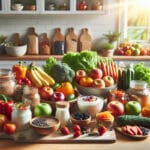The Shift from Artificial Additives to Natural and Functional Ingredients in Food Products
In 2025, the global food industry is undergoing one of its most significant transformations in decades. Driven by consumer demand for transparency, new regulatory pressures, and technological innovation, brands are rapidly moving away from artificial additives in food toward natural and functional ingredients. This shift marks a new era of clean-label reformulation that impacts everything from snacks and beverages to frozen meals and condiments.
Why Artificial Additives Are Being Phased Out
Artificial additives — including synthetic dyes, chemical preservatives, and artificial flavors — have long been used to extend shelf life, enhance color, and create uniform taste. However, growing awareness of potential health concerns and environmental impacts has led consumers to question their safety and necessity. According to the Institute of Food Technologists (IFT), 2025 marks a tipping point where clean label and functional formulations are no longer niche but mainstream expectations.
Key Drivers Behind the Shift
- Consumer Health Awareness: Shoppers increasingly associate artificial additives with hyperactivity, allergies, and gut health concerns.
- Regulatory Reform: Governments and agencies worldwide are tightening oversight on additive safety and labeling transparency.
- Retailer Leadership: Major retailers like Walmart are setting new standards by removing synthetic dyes from all private-label food products.
- Technological Innovation: Advances in precision fermentation and plant-based chemistry are enabling natural replacements for synthetic ingredients.
Regulatory Landscape: Food Additive Regulations 2025
Regulatory agencies are updating their frameworks to reflect new scientific understanding of additive safety. The IFT’s 2025 Food Trends report highlights how the FDA and international bodies are prioritizing ingredient transparency and functional nutrition. These updates are expected to influence reformulation across the food supply chain, from ingredient sourcing to labeling requirements.
| Regulatory Focus Area | 2025 Direction |
|---|---|
| Artificial Colorants | Encouraging natural pigments from fruits, vegetables, and algae |
| Preservatives | Promoting natural antimicrobials like rosemary extract and cultured sugar |
| Flavor Enhancers | Supporting yeast-based and fermentation-derived flavor compounds |
How Major Brands Are Reformulating
Leading food companies are responding to both consumer and regulatory pressure by reformulating products. Walmart’s 2025 announcement to eliminate synthetic dyes across all private brands is a landmark move that signals a broader industry trend. This initiative aligns with consumer expectations for safer, more natural products and sets a precedent for other retailers and manufacturers to follow.
Examples of Reformulation Strategies
- Replacing Synthetic Dyes: Using beet juice, turmeric, and spirulina extracts for natural color.
- Natural Preservatives: Leveraging plant-based antioxidants and fermented ingredients to maintain freshness.
- Functional Ingredients: Incorporating probiotics, adaptogens, and fiber-rich compounds for added health benefits.
- Precision Fermentation: Creating flavor and texture enhancers from microbial fermentation instead of petrochemical sources.
The Rise of Clean Label Food Ingredients
Consumers now expect ingredient lists they can understand. Clean label food ingredients — those that are minimally processed, naturally derived, and free from artificial additives — are becoming the gold standard. According to Food Dive’s 2025 trend analysis, clean label snacks and beverages are leading sales growth, particularly among younger consumers who prioritize transparency and sustainability.
Top Clean Label Trends for 2025
- Plant-Based Additives: Extracts from herbs, fruits, and roots replacing synthetic stabilizers.
- Functional Nutrition: Ingredients that support immunity, energy, and mental focus.
- Minimal Processing: Cold-pressed and fermented components preserving natural nutrients.
Health and Environmental Impacts
Reducing artificial additives in food benefits both personal health and the environment. Natural alternatives often require less chemical processing and generate fewer pollutants. From a health perspective, removing synthetic dyes and preservatives reduces exposure to compounds linked to behavioral and metabolic concerns. As consumers increasingly connect food choices with wellness, this shift supports a more sustainable food ecosystem.
Technology’s Role: Precision Fermentation and AI Ingredient Analysis
Technological innovation is accelerating the transition to natural and functional ingredients. Precision fermentation allows scientists to produce natural flavors, colors, and proteins using microorganisms instead of synthetic chemicals. Meanwhile, AI-driven tools like Food Scan Genius empower consumers to understand ingredient labels instantly.
Food Scan Genius helps users scan packaged foods to identify artificial additives, allergens, and hidden ingredients. As one user shared: “I love how Food Scan Genius tells me which additives are natural and which to avoid — it’s like having a food scientist in my pocket.” Try it yourself at scangeni.us.
Challenges in Removing Artificial Additives
Despite progress, eliminating artificial additives isn’t simple. Reformulating products can affect taste, texture, and shelf life. Natural preservatives may be less potent, and natural colorants can vary in stability. Brands must balance consumer expectations for clean labels with the realities of product performance and cost.
Common Reformulation Challenges
- Maintaining flavor consistency without artificial enhancers
- Ensuring food safety with shorter shelf lives
- Managing higher ingredient costs
- Educating consumers about natural variability
Global Context: A Worldwide Movement
This shift isn’t limited to the U.S. — global markets are following suit. European and Asian regulators are tightening additive approvals, while multinational brands are standardizing clean label formulations across regions. As the IFT notes, the convergence of science, sustainability, and consumer trust is shaping the next generation of food innovation.
FAQs About Artificial Additives in Food
1. What are artificial additives in food?
Artificial additives are synthetic substances added to food to enhance flavor, color, texture, or shelf life. Common examples include artificial dyes, preservatives, and flavor enhancers.
2. Why are companies removing artificial additives in 2025?
Companies are responding to consumer demand for clean labels, new FDA and international regulations, and retailer initiatives like Walmart’s elimination of synthetic dyes.
3. What are natural alternatives to synthetic preservatives?
Natural preservatives include rosemary extract, cultured sugar, vinegar, and plant-based antimicrobials that help extend shelf life safely.
4. How does removing artificial dyes affect food products?
It can slightly alter color intensity or hue, but consumers increasingly prefer natural tones derived from fruits, vegetables, and algae extracts.
5. What role does technology play in this transition?
Technologies like precision fermentation and AI-based ingredient analysis are enabling safer, more sustainable replacements for synthetic additives.
6. How can consumers identify artificial additives?
Reading ingredient labels and using tools like Food Scan Genius can help identify synthetic compounds and choose cleaner alternatives.
Takeaway: The Future of Food Is Transparent and Functional
The move away from artificial additives in food represents a major step toward a more transparent, health-focused, and sustainable food system. As regulatory updates, retailer commitments, and scientific innovations converge, consumers can expect cleaner, more functional, and naturally preserved products on store shelves. Understanding what’s in your food — and why it’s there — is now easier than ever with tools like Food Scan Genius, empowering everyone to make informed, confident choices.





